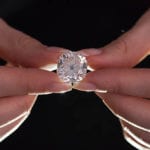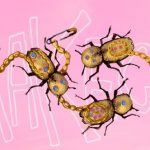 Weird Stuff
Weird Stuff  Weird Stuff
Weird Stuff  Our World
Our World 10 Ways Your Christmas Tree Is More Lit Than You Think
 Movies and TV
Movies and TV The 10 Coolest Stars to Set Sail on The Love Boat
 History
History 10 Things You Didn’t Know About the American National Anthem
 Technology
Technology Top 10 Everyday Tech Buzzwords That Hide a Darker Past
 Humans
Humans 10 Everyday Human Behaviors That Are Actually Survival Instincts
 Animals
Animals 10 Animals That Humiliated and Harmed Historical Leaders
 History
History 10 Most Influential Protests in Modern History
 Creepy
Creepy 10 More Representations of Death from Myth, Legend, and Folktale
 Technology
Technology 10 Scientific Breakthroughs of 2025 That’ll Change Everything
 Weird Stuff
Weird Stuff Ten Bizarre Facts About The Doge Meme
 Our World
Our World 10 Ways Your Christmas Tree Is More Lit Than You Think
 Movies and TV
Movies and TV The 10 Coolest Stars to Set Sail on The Love Boat
Who's Behind Listverse?

Jamie Frater
Head Editor
Jamie founded Listverse due to an insatiable desire to share fascinating, obscure, and bizarre facts. He has been a guest speaker on numerous national radio and television stations and is a five time published author.
More About Us History
History 10 Things You Didn’t Know About the American National Anthem
 Technology
Technology Top 10 Everyday Tech Buzzwords That Hide a Darker Past
 Humans
Humans 10 Everyday Human Behaviors That Are Actually Survival Instincts
 Animals
Animals 10 Animals That Humiliated and Harmed Historical Leaders
 History
History 10 Most Influential Protests in Modern History
 Creepy
Creepy 10 More Representations of Death from Myth, Legend, and Folktale
 Technology
Technology 10 Scientific Breakthroughs of 2025 That’ll Change Everything
10 Nuggets That Show Gold Is Weirder Than You Think
Gold is famous for its beauty and financial value. Beyond that, the metal is not very interesting. Or is it?
Throughout history, people have used gold in bizarre ways, and modern discoveries also hold a few surprises. From a Renaissance alchemist who died full of glitter to a massive fortune floating in sewers, here are ten strange facts about gold.
Related: Top 10 Things Inherently More Valuable Than Gold
10 Fool’s Gold Has Real Gold
The mineral pyrite is called “fool’s gold” because it mimics the real deal so closely. And for centuries, people were told that pyrite contained no gold, so just chuck it away!
But during the 1980s, researchers discovered that pyrite contains two types of genuine gold, meaning that many miners might’ve missed a fortune. The precious metal appears as either pure particles or an alloy of finely mixed gold and pyrite. A third type was discovered in 2021—and it’s a little odd. When pyrite forms under extreme pressure or high temperatures, its crystal structure can develop faults that are lined with gold atoms.
The amount of gold in pyrite is so small that it cannot be seen under standard microscopes. However, due to the abundance of fool’s gold, this resource can still become a boon for the gold industry when better extraction methods are invented.[1]
9 A Massive Bar of Stolen Gold
In 1981, in Mexico City, construction workers were digging at a building site when one man found a big bar of gold. The treasure had an old, pitted appearance and weighed around 4.25 pounds (1.93 kg). Its apparent age and size suggested that the bar was Aztec treasure looted and melted down by the Spanish conquistadors.
On the night of June 30, 1520, the Spanish realized an Aztec rebellion was brewing, and they grabbed all the gold they could from Tenochtitlán (modern-day Mexico City) and ran. But one of their ships sank, and many Aztec treasures were lost. What supported the notion that the bar was on the doomed ship was that it was found in the now dried-up canal where the vessel sank.
However, it wasn’t until 2022 that scientists could prove it. Tests showed that the bar’s chemical composition was roughly 76% gold, 21% silver, and 3% copper—the same fingerprint as other gold artifacts recovered from the main temple in Tenochtitlán.[2]
8 Rare Golden Dental Braces
Anne d’Alègre was an aristocrat in 17th-century France. Despite moving in higher circles, her life was short and stressful. She lost two husbands and an adult son, and as a Protestant, she had to hide from Catholic forces who seized her properties. She died in 1619 at the age of 54.
When archaeologists discovered her coffin in 1988, they noted she had wiring fixed to her teeth. But it wasn’t until x-rays were taken in 2022 that scientists realized the wires were gold. The scan also showed that she had severe periodontal disease, which could have been a result of her difficult life. To prevent her loose teeth from falling out—something a high-society French woman couldn’t allow—she had her teeth tied with gold wires.
The dental work was innovative for the time but it wasn’t perfect. The braces had to be tightened every now and again, and some teeth were drilled so the wires could pass through them. This destabilized her healthy teeth and likely caused her permanent excruciating pain.[3]
7 Ant Nests Lead to Treasure
Australia depends heavily on mineral resources to support its economy. Indeed, exporting gold and other minerals puts $86 billion into the country’s pocket every year. However, there’s a problem. All of Australia’s surface mineral deposits have been discovered. Miners must now explore deeper, but traditional methods like drilling are expensive and often miss the mark.
A bizarre method of prospecting might help. A 2012 research paper revealed how scientists discovered high concentrations of gold inside ant and termite mounds in the West Australian goldfields. As it happens, the insects tunnel deep underneath their homes and bring pieces of the precious metal back to their nests.
By finding nests that stockpile gold, miners can more accurately locate large deposits of minerals underground. This approach is also more cost-effective and environmentally friendly than digging for gold willy-nilly and hoping to strike it lucky.[4]
6 Gold Makes Wine Smell Better
The wine industry has a big problem. Certain methods of winemaking produce aromas so terrible that they have been described as “rubber” and “rotten eggs.” This is bad for business as few consumers will buy wine that smells like a tire. The industry often adds copper sulfate to remedy the situation, but this is not ideal because the compound is toxic.
In recent times, scientists from Australia found a better way to remove the reek. They coated special strips with specks of gold and then tested the strips on wines high in volatile sulfur compounds (the cause of the bad smells). Remarkably, when the strips were left in the wine samples for 24 hours, up to 45% of the offending sulfur compounds were removed.
The golden filtration system is not only quick, non-toxic, and eco-friendly, but it can also be used throughout the winemaking process as equipment and packaging can be coated with gold nanoparticles as well, something that could potentially remove even more sulfur.[5]
5 This Bacteria Poops Gold
Meet Cupriavidus metallidurans. This goober eats toxic metallic compounds and excretes small gold nuggets. The microbes’ unusual ability was discovered in 2009. At the time, no one could explain how they managed this feat without dying. Nine years later, in 2018, while under the scrutiny of an international team of scientists, the bug spilled the beans.
The bacteria happily live in soil that would end many other organisms, and that is earth filled with toxic metals and hydrogen. Two of these deadly compounds are gold and copper, which swiftly enter the bacteria and sink into their bodies, where the damage could be potentially severe.
However, C. metallidurans have an ingenious protective mechanism. They use a special enzyme to reduce the effects of the metals on their cells. Called CopA, it makes gold and copper harder to absorb. This ensures that fewer of these metals get into the bacteria’s inner works while also allowing the organisms to excrete any unwanted materials that do get absorbed, resulting in tiny gold nuggets forming on their outside surface.[6]
4 Sewage Is a Gold Mine
Nobody wants to spend too much time thinking about sewage. But some scientists are obsessed with it. Why? Because sewage sludge is worth millions.
“Sludge” is what remains after storm run-off, toilet water, and industrial waste are treated. It’s always been known that this goop contains metals, which makes nearly half of it worthless as fertilizer and unsafe to release into rivers.
In seeking a solution, researchers analyzed the waste more closely and discovered it was also packed with valuable metals. A city with a million citizens could sit on sludge worth between $8 million and $13 million. Samples from across the U.S. revealed that apart from millions of dollars worth of gold, other lucrative metals included silver, titanium, copper, palladium, cadmium, manganese, and more.
But why are sewage drains filled with treasure worthy of a dragon’s den? It’s not the result of people ingesting these metals and going to the bathroom. The compounds end up in sewers due to manufacturing processes and disposal, mostly from mining, electronics, jewelry-making, and automotive industries.[7]
3 Jason’s Myth Was Based on Real Events
In Greek mythology, Jason was tasked with retrieving the legendary Golden Fleece from the Colchis Kingdom. Researchers believe that the fictional quest was based on a real journey that happened between 3,300 and 3,500 years ago. During this voyage, travelers encountered villages in the Svaneti region of Georgia near the Black Sea (where the Colchis Kingdom was located). Here, they saw a local tradition that inspired the legend of Jason.
The surrounding mountains had deposits of gold, but the villagers didn’t need to take pick axes to the rock to extract the metal. Thanks to erosion, the gold washed into rivers, and locals could simply lower sheepskins into the water as “filters” to catch the precious flakes as they floated downstream. These gold-filled fleeces undoubtedly fueled the legend of the Golden Fleece.
Interestingly, this method of mining was never abandoned. Thousands of years later, people in this region still use sheepskin to collect gold from streams.[8]
2 Plastic Gold That’s Real Gold
Many people enjoy the beauty and prestige of wearing gold. The precious metal is copiously used to manufacture rings, necklaces, wristwatches, and more. Although gold accessories remain as popular as ever, there is one drawback—the stuff is heavy.
An innovative team of scientists may have the answer. In 2020, they created gold with plastic properties, all without sacrificing its 18-carat standing. This feat was achieved by creating a hybrid substance containing gold and plastic. The manufacturing process is complex, but the results are incredible. The material is about five to ten times lighter than traditional gold, sounds like plastic when it hits the floor, glimmers like gold, and is malleable enough to be shaped into the desired form.
“Plastic gold” is not just useful for more comfortable jewelry and watches, but apparently, it’s also suitable for applications in electronics, chemical catalysis, and radiation shielding.[9]
1 This Alchemist Died Full of Gold
Born in 1546, Tycho Brahe was famous for several things. He had a pet moose. He had a fake nose (the real one was lost in a duel). Incredibly wealthy, Brahe also owned 1% of Denmark, his country of birth. By the time he was 30, the Dane was touring Europe as a highly respected astromer and alchemist.
In 2016, various hair samples showed Brahe had 20 to 100 times more gold in his system than people today. The study concluded that he’d been excessively exposed to the precious metal, especially during the last two months of his life. As an alchemist, gold would’ve been very important in his experiments, and Brahe was rich enough to buy a bar whenever he needed it. But how did it end up in his body?
Gold was abundant in the wealthy circles he moved in. Brahe might’ve ingested it when cutlery scraped against the gold trimmings on his plate or when gold was purposefully added to his food or wine, as was trendy during Renaissance Europe. Perhaps he consumed it during alchemy rituals. The truth is, we’ll never know how Brahe died full of gold. [10]








